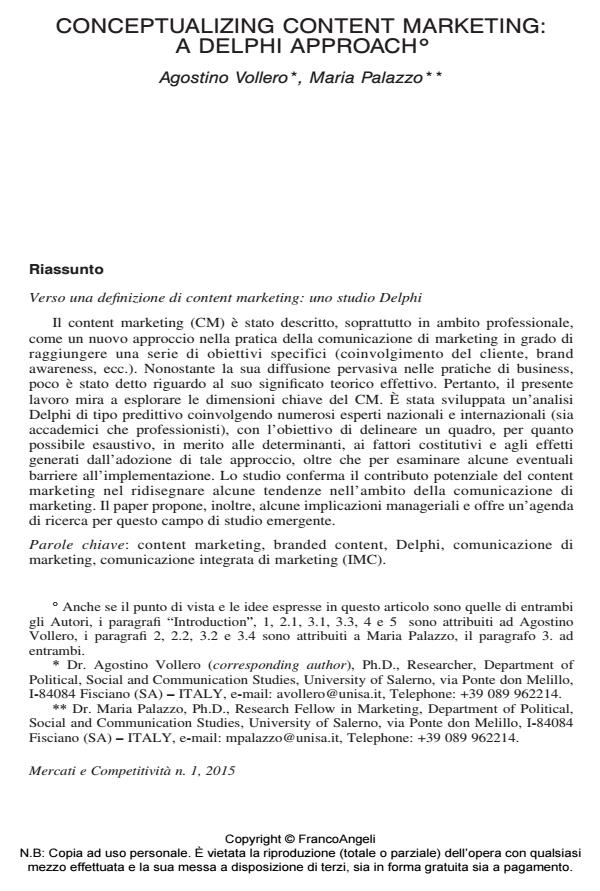Conceptualizing content marketing: a delphi approach
Titolo Rivista MERCATI E COMPETITIVITÀ
Autori/Curatori Agostino Vollero, Maria Palazzo
Anno di pubblicazione 2015 Fascicolo 2015/1
Lingua Italiano Numero pagine 20 P. 25-44 Dimensione file 102 KB
DOI 10.3280/MC2015-001003
Il DOI è il codice a barre della proprietà intellettuale: per saperne di più
clicca qui
Qui sotto puoi vedere in anteprima la prima pagina di questo articolo.
Se questo articolo ti interessa, lo puoi acquistare (e scaricare in formato pdf) seguendo le facili indicazioni per acquistare il download credit. Acquista Download Credits per scaricare questo Articolo in formato PDF

FrancoAngeli è membro della Publishers International Linking Association, Inc (PILA)associazione indipendente e non profit per facilitare (attraverso i servizi tecnologici implementati da CrossRef.org) l’accesso degli studiosi ai contenuti digitali nelle pubblicazioni professionali e scientifiche
Il content marketing (CM) è stato descritto, soprattutto in ambito professionale, come un nuovo approccio nella pratica della comunicazione di marketing in grado di raggiungere una serie di obiettivi specifici (coinvolgimento del cliente, brand awareness, ecc.). Nonostante la sua diffusione pervasiva nelle pratiche di business, poco è stato detto riguardo al suo significato teorico effettivo. Pertanto, il presente lavoro mira a esplorare le dimensioni chiave del CM. È stata sviluppata un’analisi Delphi di tipo predittivo coinvolgendo numerosi esperti nazionali e internazionali (sia accademici che professionisti), con l’obiettivo di delineare un quadro, per quanto possibile esaustivo, in merito alle determinanti, ai fattori costitutivi e agli effetti generati dall’adozione di tale approccio, oltre che per esaminare alcune eventuali barriere all’implementazione. Lo studio conferma il contributo potenziale del content marketing nel ridisegnare alcune tendenze nell’ambito della comunicazione di marketing. Il paper propone, inoltre, alcune implicazioni manageriali e offre un’agenda di ricerca per questo campo di studio emergente.
Parole chiave:Content marketing, branded content, Delphi, comunicazione di marketing, comunicazione integrata di marketing (IMC).
- The importance of content marketing for achieving customer brand engagement Nermana Mahmić-Muhić, Almir Klico, in BH Ekonomski forum /2022 pp.131
DOI: 10.5937/bhekofor2201131M - Identifying consumer-based digital content marketing consumption motives: a qualitative study Shelleka Gupta, Ronnie Dutt, in Journal of Advances in Management Research /2024 pp.584
DOI: 10.1108/JAMR-08-2023-0218 - The Emerald Handbook of Multi-Stakeholder Communication Rahime Zaman Fashami, Manijeh Haghighinasab, Nader Seyyedamiri, Pari Ahadi, pp.281 (ISBN:978-1-80071-898-2)
- Don't forget about customer magazines: the effects of reading experiences on customer magazine effectiveness Clemens Koob, in Frontiers in Communication 1195620/2023
DOI: 10.3389/fcomm.2023.1195620
Agostino Vollero, Maria Palazzo, Conceptualizing content marketing: a delphi approach in "MERCATI E COMPETITIVITÀ" 1/2015, pp 25-44, DOI: 10.3280/MC2015-001003